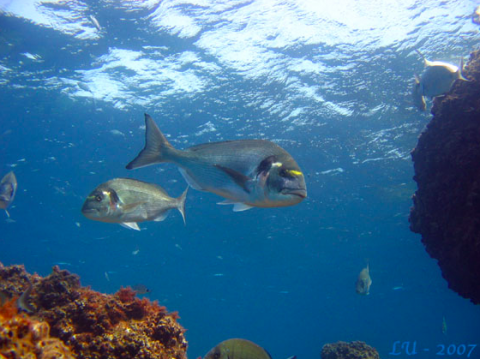
PhD defense in marine biology of Solène AVIGNON entitled:
"Impact of the spatio-temporal evolution of the northern distribution limit on life history traits in the gilthead seabream Sparus aurata".
The defense will takes place on Thursday, 6th of July at 9:30 am, at the Marine Biological Station of Concarneau conference room, Place de la Croix, 29900 Concarneau.
The jury will be composed as follows:
Mrs Daverat Françoise, IRSTEA Bordeaux, rapporteur
Mr Hunter Ewan, CEFAS Lowesoft (UK), rapporteur
Mrs Chenuil Anne, IMBE Marseille, examinateur
Mr Laroche Jean, LEMAR IUEM Brest, examinateur
Mr Zambonino José-Luis, IFREMER Brest, examinateur
Mr Duhamel Guy, MNHN Paris, supervisor
Mrs Denis Françoise, Le Mans Université, co-supervisor
Thesis abstract:
The gilthead seabream (Sparus aurata) is a sparidae species whose natural distribution stretches from Senegal to Ireland coasts, with its common habitat in the Mediterranean Sea. This species is still considered as rare in its northern limit of distribution. For a decade, the abundance of individuals caught in the northern limit (English Channel, Irish Sea and North Sea), has increased. This species is now a fishing resources in the English Channel. This phenomenon, in link with global warming, is explained by the northern expansion of its distribution range. No ecological data about this species in northern distribution range is currently published. Life history traits of S. aurata in relation to the spatio-temporal modification of its distribution range has been studied, through diet, growth and sea/coastal movement analysis. On the other hand, the population structure analysis of these northern populations has been done with a multi-marker approach coupling the genetics and otolith microchemistry.
Analysis of the stomach contents of S. aurata at the northern range confirms an opportunistic diet with a high proportion of prey species from the genus Mytilus. The growth of individuals is lower than that observed on individuals in the Mediterranean Sea. This phenomenon is conditioned by environmental parameters (temperature, salinity) at the distribution range limit. Elemental composition of the otoliths allowed us to characterize the sea/coastal migrations during the first year of life, with a sea transition in winter and the occupation of coastal zones. A variability between individuals has been observed as a behavioral plasticity of individuals. This suggests the presence of nursery areas along the Atlantic and Channel Sea coasts. Otolith microchemistry and genetic approaches, combining the use of mitochondrial and microsatellites markers, have demonstrated the lack of structure within populations at the northern distribution range. This phenomenon matches with the recent population colonization. However, a differentiation was identified between the most southern individuals sampled and those at the northern sampling boundary, suggesting little genetic mixing. Common alleles between individuals suggest a “step by step” colonization of individuals from the Mediterranean Sea. Genetic and life history traits differences were observed between individuals sampled in the Channel Sea, suggesting a biogeographic barrier within this environment.
Favorable environmental conditions are a major asset for this predatory species, which appears to have a huge acclimatization ability. All the various approaches discussed in this work have then made it possible to provide the first data on the life characteristics and the population structure of a species with a high commercial interest on the northern range of its distribution.
